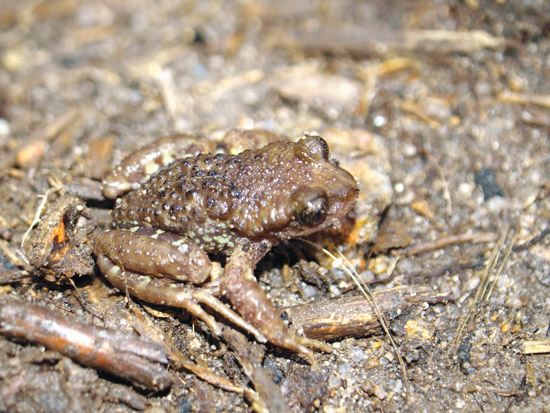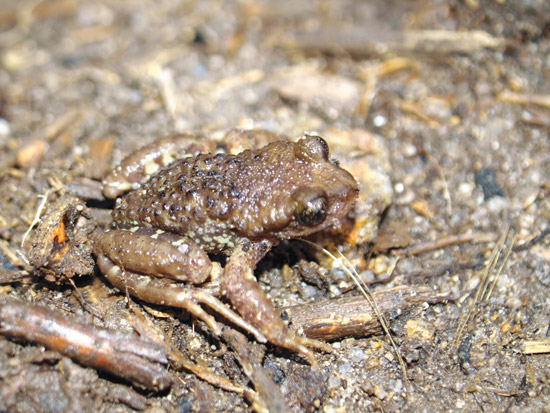(No.2, Vol.4, Mar-April 2014 Vietnam Heritage Magazine)
Vietnamese and German scientists have announced the finding of a new species of mountain toad on Fan-si-pan in Lao Cai Province in the northwest. This toad has scientific name Oreolalax sterlingae [Nguyen, Phung, Le, Ziegler & Boehme, 2013], and was described in an American scientific journal, Copeia, no.2, June 2013:

Oreolalax sterlingae
I found this new toad species during an adventure trip to conquer Fan-si-pan, the rooftop of Indochina, in April, 2010, with a few friends from Ho Chi Minh City. I immediately suspected that this was a new species [of toad] in Vietnam, because I can’t recall seeing any mountain toad that was so strange. After an exhausting day of hiking from the Ton camp site (1,900 m) to the rest site at 2,800m, everybody was out of breath because of the long, steep slopes of the mountain. It was dark, and the rain got heavier. The cold penetrated the flesh of those from the ‘land without winter’, making them cling to each other, because they had never had to endure such cold. We tried to eat and sleep to regain strength for the next day’s hiking. Thank God, the sleeping bags were warm. But, as I am an independent researcher, and because this was a rare chance for me to collect a specimen and take good pictures for the website www. vncreatures.net, I decided to take a H’Mong guide with me and move on to the peak (3,143 m) immediately, despite the perils that multiplied by the night. The slippery road, from time to time, made me practice ‘hind-landing’. But it was the whipping cold wind, together with the rain and the cold mist that made my teeth clap incessantly. At the height of 2,900m, in a stream bed lined with moss-covered rocks and thick with bush trees of the baboo family (Poaceae), I saw two mountain toads under the torch light that sluggishly penetrated the fog. They were mating. I knew that I was disrupting their happy moment, that I was ‘heartless’, but this toad couple had to sacrifice in the name of science. Moreover such a chance may never come again in my life. Our legs numbed by the cold, we stopped and crawled in to a sleeping bag. Covered by a water proof canvas, a raincoat and warm clothes, the H’Mong young man and I shared body warmth in the darkness and raging winds to wait for daylight. The next day, when the mist was lifted by the wind and sunlight, I was able to take photos of the toads to announce a new find.
Dr. Nguyen Quang Truong from the Institute of Ecology and Biological Resources told us, ‘After collecting data about this species, we analysed the DNA and concluded that this is a new species in Vietnam, because before that, it was found only in China.” We divided the work among the group members. Dr. Le Duc Minh (Hanoi National University) did the molecular biology analysis and comparison. Dr. Nguyen Quang Truong analysed samples of other mountain toads species kept in the museums of Paris, Bonn (Germany) and Kunming (China). One difficulty was that most of the published materials of Chinese scientists on frogs and toads are in Mandarin. We had to ask our colleagues at the Sichuan Institute of Biology (China) to translate into English the description of related species found in China. After over a year of data collection, the paper was finally accepted by Copeia, a prestigious journal of the American Society of Ichthyologists and Herpetologists (ASIH). This journal has also published many papers on the discovery of Oreolalax and many other species of this breed.
After two rounds of critical analysis by specialists, at the end of 2012, the paper was accepted by Copeia. However, there was another unforeseen problem: the journal required the author group to pay quite a high publishing fee: $110 per page, which was $1,100 for the whole paper. Luckily, Professor Wolfgang Boehme, a member of the author group, was an honorary member of ASIH, so the fee was not charged.
*Phung My Trung is a freelance researcher in biodiversity
,,
,,

